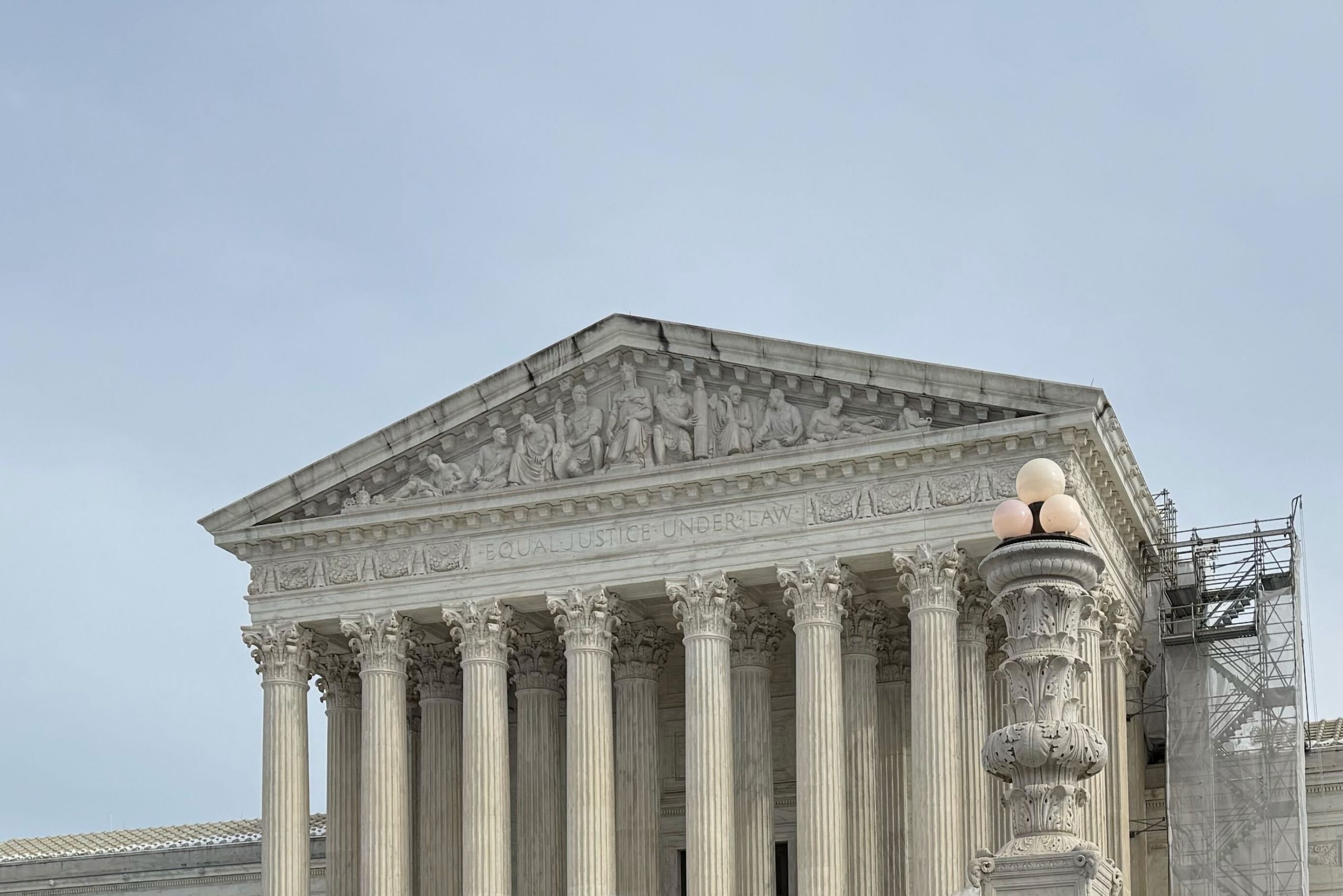Court to hear major gun-rights dispute over domestic-violence restrictions
CASE PREVIEW
on Nov 6, 2023
at 4:58 pm
The justices will hear United States v. Rahimi on Tuesday. (Tori Madden)
A Texas man’s challenge to the constitutionality of a federal law that bars anyone subject to a domestic-violence restraining order from possessing a gun will come before the justices in oral argument on Tuesday. A federal appeals court in Louisiana agreed with Texan Zackey Rahimi, that the law, 18 U.S.C. § 922(g)(8), violates the Second Amendment, which protects “the right of the people to keep and bear Arms.” But the Biden administration contends that the decision by the U.S. Court of Appeals for the 5th Circuit “endangers victims of domestic violence, their families, police officers, and the public.”
United States v. Rahimi is the court’s first Second Amendment case since its 2022 decision in New York State Rifle & Pistol Association v. Bruen, in which the justices struck down New York’s handgun-licensing scheme. In Bruen, the majority explained that courts should uphold gun restrictions only when there is a tradition of such regulation in U.S. history. In Rahimi, the court will have an opportunity to say more about how to apply this test – a question with which the lower courts have struggled.
At the center of Rahimi’s challenge is the Feb. 2020 civil protective order entered against him in a state court in Texas. The order stemmed from a Dec. 2019 incident in a parking lot in which Rahimi (among other things) dragged his then-girlfriend, who is also the mother of his child, back to his car when she tried to leave after an argument. Rahimi pushed her inside the car, where she hit her head on the dashboard. And when Rahimi realized that someone had witnessed the incident, he fired a gun at the bystander.
The civil protective order entered in a Texas state court barred Rahimi from committing further violence. It also prohibited him from going within 200 yards of the woman’s home and workplace, harassing both the woman and her family, and from having a gun. Rahimi was soon arrested for violating the restraining order, and he was charged with using a gun to threaten another woman.
In Dec. 2020 and Jan. 2021, while the civil protective order was still in effect, Rahimi was involved in five shootings, including one incident in which he was involved in a car accident and shot at the driver of the other car and another in which he fired into the air after his friend’s credit card was declined at a fast-food restaurant.
When police identified Rahimi as a suspect in the shootings and obtained a warrant to search his home, they found a rifle and pistol. Because the civil protective order explicitly barred him from having a gun, he was indicted on charges that he had violated Section 922(g)(8).
Rahimi asked the court to dismiss the indictment, arguing that the law is unconstitutional. Before the Supreme Court issued its decision in Bruen, both a federal district court and the 5th Circuit initially upheld the law, rejecting Rahimi’s challenge.
But in March of this year, the 5th Circuit issued a new opinion deeming Section 922(g)(8) unconstitutional and vacating Rahimi’s conviction. It acknowledged that, after Bruen, the government is not required to identify a “historical twin” to Section 922(g)(8). Instead, the court of appeals explained, it is enough for the government to offer a “well-established and representative analogue.” But the government had failed to do so in Rahimi’s case, the court of appeals concluded.
The Biden administration quickly came to the Supreme Court, asking the justices to weigh in – which they agreed to do on June 30.
The government tells the justices that the 5th Circuit’s decision “misreads the history of the Second Amendment.” Laws from before, at, and after the founding of the United States all established that when the Second Amendment was enacted, the Biden administration contends, Congress had the power to disarm individuals “who are not law-abiding, responsible citizens.”
That is precisely what Section 922(g)(8) does, the Biden administration argues. “Individuals subject to domestic-violence protective orders pose an obvious danger to their intimate partners because guns often cause domestic violence to escalate to homicide and because abusers often use guns to threaten and injure their victims.” Moreover, the Biden administration adds, the high bar before a protective order can trigger Section 922(g)(8) means that the ban only applies to “a particularly dangerous and irresponsible subset of persons subject to protective orders” – for example, the protective order must either find that the person subject to the order “represents a credible threat” to someone else’s “physical safety,” or it must specifically prohibit the use of “physical force.”
The 5th Circuit’s application of Bruen’s historical test was far too narrow, the Biden administration insists. It does not need to identify a historical twin to laws like Section 922(g)(8), the Biden administration asserts – only an analogue. And it has done so, identifying “many historical laws that impose the same type of burden as Section 922(g)(8) (disqualifying someone from possessing arms) for the same type of reason (the person is not responsible enough to be trusted with arms).”
Requiring a more specific match would be especially inappropriate in a case like this one, the Biden administration continues, because of the changes in how both law and society have addressed domestic violence. For example, the Biden administration notes, “past generations could not have disarmed persons subject to protective orders because such orders did not exist.”
Members of Congress, led by Sen. Richard Blumenthal, a Democrat from Connecticut, filed a “friend of the court” brief supporting the Biden administration. They tell the justices that if the 5th Circuit’s decision is allowed to stand, the lower court’s approach “would unduly shackle Congress to the past, rendering it unable to develop innovative solutions for the benefit of the public.” And they warn that both the Supreme Court and the lower courts will be flooded with new challenges to “all sorts of widely accepted gun laws that this Court had suggested are well within the bounds of the Second Amendment.” The Supreme Court, the members of Congress caution, “must stem the tide if it does not want courts to relitigate Bruen for years to come.”
Rahimi pushes back against the Biden administration’s contention that it does not need to provide a closer historical analogue to Section 922(g)(8) because there was no such thing as a domestic-violence restraining order in early U.S. history. Early American history “recognized the scourge of domestic violence,” Rahimi asserts, “and utilized a variety of legal and extra-legal mechanisms to punish, prevent, and deter it” – for example, by prosecuting abusers for assault, requiring them to put up a bond to guarantee good behavior, or allowing a victim of abuse to obtain a divorce or separation. This use of “materially different means” to address the same problem targeted by Section 922(g)(8), Rahimi concludes, “tends to prove” that the statute is unconstitutional.
Rahimi resists the government’s contention that Section 922(g)(8) only bans the possession of guns by individuals who are truly dangerous. The statute’s ban, he observes, “applies to any order prohibiting abuse” as long as both the person seeking the protective order and the subject of the order are or were “intimate partners” and there was an opportunity for a hearing. Therefore, he says, it applies to protective orders in which there was no finding that the subject of the order had actually made threats or been violent.
Two “friend of the court” briefs filed by public defenders in support of Rahimi echo his argument about the lack of safeguards to ensure that Section 922(g)(8) only applies to people who are dangerous. One of those briefs, filed by public defenders from the Bronx and the National Association of Criminal Defense Lawyers, tells the justices “unequivocally” that the government’s assurances are “false.” “The process for issuing an order of protection is superficial and swift,” the public defenders explain – so much so that “[c]ourts regularly issue full stay-away orders within seconds of appearances being entered on the record.”
Rahimi agrees with the Biden administration that it does not need to provide a “historical twin” to Section 922(g)(8) to prevail. But the problem, Rahimi contends, is that the Biden administration also “cannot point to a close relative, a distant cousin, or anything bearing even a passing resemblance” to Section 922(g)(8). Indeed, Rahimi tells the justices, the government’s failure to identify any early American laws that prohibited the possession of all guns suggests that U.S. law “recognized a zone of immunity surrounding the privately owned guns of citizens.”
This article was originally published at Howe on the Court.






